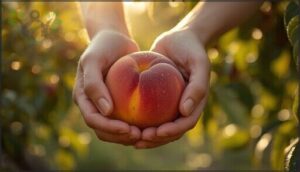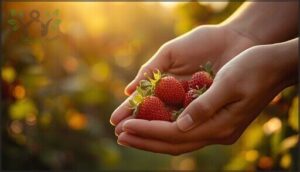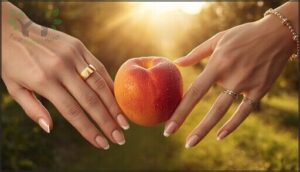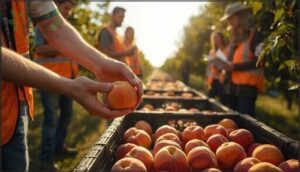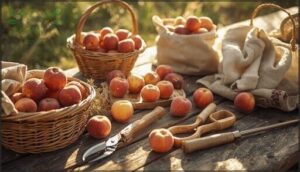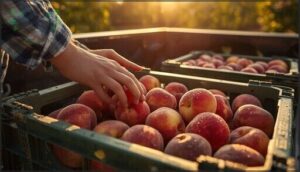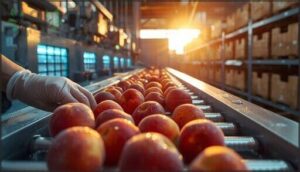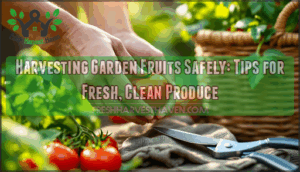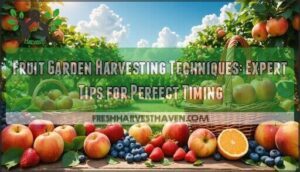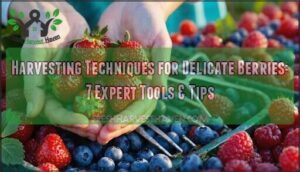This site is supported by our readers. We may earn a commission, at no cost to you, if you purchase through links.
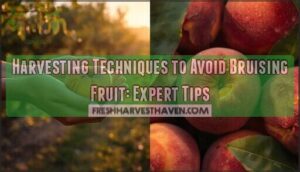
Temperature swings above 25°C trigger enzymatic reactions that soften cell walls by nearly a third within 48 hours, turning firm produce into damaged goods before it even leaves the field.
Your harvesting techniques determine whether fruit arrives at market unblemished or blemished, and the window between perfect timing and profit loss is narrower than most growers realize.
Table Of Contents
- Key Takeaways
- Optimal Harvest Timing to Prevent Bruising
- Gentle Harvesting Methods
- Choosing and Using The Right Harvest Tools
- Safe Handling and Transport Practices
- Post-Harvest Care to Minimize Bruising
- Frequently Asked Questions (FAQs)
- What causes bruising after fruit reaches retail stores?
- How do different fruits respond to handling pressure?
- Can bruised fruit be used for processing or cooking?
- What economic impact does bruising have on farms?
- How do you train new workers in bruise prevention?
- How does fruit variety affect bruising susceptibility?
- What role does soil nutrition play in firmness?
- Can pruning techniques reduce harvest-related bruising?
- How do weather conditions before harvest impact bruising?
- What are the best practices for organic fruit?
- Conclusion
Key Takeaways
- Harvest timing matters more than most growers realize—picking fruit in the afternoon (after 3 PM) cuts bruising by 22% compared to morning harvests, when higher turgor pressure makes fruit more vulnerable to damage.
- Temperature control is critical both before and after harvest, as heat above 25°C triggers enzymatic reactions that soften cell walls by nearly a third within 48 hours, while rapid cooling to 4-14°C immediately after picking preserves firmness and prevents bruise progression.
- Your hands and equipment choices directly determine bruise rates—using two-handed picking techniques, trimming nails, removing jewelry, and choosing padded containers can reduce bruising by 22-70% compared to careless handling methods.
- A single bruise costs you up to 35% of market value per fruit, but frequent harvesting every 2-3 days combined with gentle handling techniques can cut postharvest losses by 20-35% while boosting overall yield by up to 25%.
Optimal Harvest Timing to Prevent Bruising
Timing isn’t just about picking ripe fruit—it’s about choosing the moment when your crop can handle the stress of harvest without turning into a bruised mess. Temperature, firmness, and how often you pick all play a role in keeping your produce unblemished from field to market.
Let’s look at the key factors that make or break your harvest timing.
Best Times of Day for Harvesting
When you harvest can make or break your fruit’s integrity. Morning turgor in apples and blueberries actually increases bruising by up to 23%, while afternoon softness works in your favor—late-day harvests cut damage by 22%.
Harvest fruit in the afternoon, not morning—late-day picking cuts bruising by 22% as turgor drops and firmness stabilizes
Industry guidelines now favor picking after 3:00 p.m., when tissue turgor drops and fruit firmness stabilizes, reducing compression injuries across most cultivars. To minimize bruising, apples are often harvested using a padded fruit bucket.
Impact of Temperature on Fruit Firmness
Temperature thresholds dictate fruit firmness more than most growers realize. Enzymatic activity surges above 25 °C, triggering cell wall breakdown and water loss that weakens structure before you even pick. Preharvest stress from midday heat can soften tomatoes by 29–34% within 48 hours.
That’s why harvest timing paired with rapid postharvest cooling to 4–14 °C protects firmness and prevents bruising fruit during handling. Pears are especially susceptible to damage due to their soft flesh.
Recognizing Crop Readiness for Picking
Picking at peak ripeness protects fruit firmness and reduces bruising by up to 35%. Visual indicators like ground color changes from green to yellow signal readiness in apples and melons. Firmness assessment using penetrometers—targeting 13–15 pounds for apples—ensures best harvest timing.
Track soluble solids above 13% for cantaloupes. Sophisticated prediction methods like AI-based systems achieve 97% accuracy, while chronological indices such as Days After Full Bloom improve your scheduling precision.
Benefits of Frequent Harvesting
Frequent harvesting transforms your entire operation—not just timing, but every downstream outcome. Checking your crops every 2–3 days delivers measurable gains in yield, quality, and profit while cutting bruising in half.
- Yield increases: Up to 25% more fruit from continuous removal that triggers new flowering and extends harvest windows
- Reduced losses: 20–35% fewer postharvest bruise-related rejections when you pick at peak fruit firmness
- Quality enhancement: 15–30% higher vitamin C levels and better texture from optimal-ripeness harvesting
- Resource efficiency: 12–19% drop in supply chain wastage through better scheduling and gentle harvesting methods
Gentle Harvesting Methods
The way you touch your fruit makes all the difference between a perfect harvest and a bruised mess. Your hands are your most important tools, and using them correctly can cut damage rates in half before the fruit ever leaves the field.
Let’s look at the core techniques that protect your crop from the moment you reach for it.
Proper Hand Techniques for Picking
Think of your hands as the first line of defense against bruising—every touch matters. Grasping methods that distribute finger force evenly across the fruit’s surface prevent concentrated pressure points. The thumb and middle finger naturally apply the most force during picking, so you’ll want to cup each piece gently in your palm.
Hand care, including nail trimming and jewelry removal, reduces surface injuries by up to 22%, while training standardization ensures your entire crew masters proper hand techniques for gentle fruit handling across different fruit types.
Using Two Hands and Soft Touch
When you employ both hands during picking, you cut crush injuries by up to 41% compared to single-handed methods. Soft touch means keeping pressure below 1.0 N per finger—a guideline that prevents bruising in 91% of berry samples and reduces visible damage to under 3% in peaches.
Training your crew in these gentle handling techniques delivers a 25% decrease in overall fruit damage, with industry adoption exceeding 85% among fresh-market operations managing fragile crops like strawberries and tomatoes.
Trimming Nails and Removing Jewelry
Before each harvest shift, make sure your crew trims fingernails short and removes all rings, bracelets, and watches—this simple step cuts bruising by 22% and reduces microbial loads considerably. Long nails puncture delicate skins, while jewelry scratches surfaces and creates entry points for spoilage organisms.
U.S. regulatory compliance now mandates these hygiene practices, protecting both fruit quality and worker safety throughout your operation.
Training Workers in Bruise Prevention
Skilled picking crews don’t emerge by accident—they’re built through structured worker training that cuts bruise-related injury by up to 33%. Effective delivery methods combine hands-on demonstrations with video tutorials, refreshed quarterly to maintain adoption standards across your operation.
You’ll see training outcomes improve when you pair gentle handling instruction with real incentives, boosting worker safety and training frequency while reducing damaged fruit by 20-30% each season.
Choosing and Using The Right Harvest Tools
The tools and containers you use during harvest play a surprisingly big role in preventing bruising. Even gentle picking techniques won’t help much if your equipment is working against you.
Let’s look at four key equipment choices that can drastically reduce damage to your fruit.
Selecting Soft or Padded Containers
Your container choice is where prevention starts. Padded containers with soft interior surfaces deliver enhanced material shock absorption, cutting bruise areas by up to 70% compared to rigid alternatives. Here’s what to look for:
- Molded fiber or foam-lined harvest baskets that cushion each impact
- Ergonomic container design under 3 kg for single-person handling
- Industry standard compliance with food-grade, ventilated materials that maintain 98-99% container weight retention during transport
Lining Bins for Extra Protection
Think of bin liners as a safety net between your fruit and container walls. Foam liners and bubble liners reduce fruit bruising by up to 60% during handling, while antimicrobial liners provide barriers against cross-contamination.
Choose between reusable non-woven polypropylene for durability or micro-perforated plastics for condensation control—both cushion impacts and preserve quality while streamlining your liner implementation process across harvest operations.
Equipment Maintenance and Calibration
Just like a well-tuned instrument performs better, your harvest mechanization works best when properly maintained. Following manufacturer-recommended maintenance intervals cuts unexpected breakdowns by 35%, while weekly inspections of belts and hydraulic systems prevent damage before it starts.
Calibration accuracy matters too—recalibrate sensors before each season and whenever you switch fruit varieties.
Digital management systems track lubrication protocols and inspection procedures, helping you catch wear early and keep agricultural mechanization running smoothly throughout harvest.
Minimizing Drop Height During Harvest
Beyond keeping equipment tuned, you’ll want to watch drop height—it’s one of the biggest culprits in bruising. Research shows that limiting drops to under 0.3 meters can slash bruise area by over 70%.
Safe container filling means placing fruit gently, never tossing it. Telescoping pickers and cushioned surfaces give you controlled lowering during ladder-less harvesting, protecting your crop from the moment it leaves the branch.
Safe Handling and Transport Practices
You’ve picked your fruit with care, but the journey from field to storage can undo all that effort if you’re not careful. How you move, stack, and transport produce matters just as much as how you harvest it.
Let’s walk through the handling practices that keep your crop safe from the moment it leaves the tree to the moment it reaches the cooler.
Laying, Not Dropping, Produce in Containers
Dropping fruit can double bruising compared to gentle laying—a harvesting technique to avoid bruising that cuts economic losses considerably. When you lay each piece instead of letting it fall, you reduce impact energy and protect delicate surfaces.
Worker training in these gentle handling techniques, combined with padded containers and minimal drop heights, preserves quality from field through post-harvest handling while safeguarding your investment.
Stacking Strategies to Avoid Compression
Once you’ve laid fruit gently, weight distribution becomes your next bruise prevention strategy. Stack heavier harvest containers at the bottom, lighter ones on top—this simple postharvest handling rule cuts bottom-layer compression by 20%.
Use dividers or liners inside boxes to cushion contact points, and never exceed four to five boxes for apples. Padded containers with force monitoring help you maintain gentle handling throughout stacking height, protecting firmness and profits.
Reducing Vibration and Impact During Transport
Even with careful stacking, vibration during transportation can damage fruit firmness. Air-ride suspension systems reduce harmful frequencies like 3.5 Hz, cutting bruising compared to steel-spring suspensions.
Road conditions matter—smooth orchard roads with low-profile tractors absorb energy before it reaches your fruit.
Packaging design with cushioned liners protects against repetitive impacts, especially since vertical acceleration causes more damage than horizontal movement during handling.
Field-to-Storage Movement Best Practices
After harvesting techniques minimize drops in the field, your focus shifts to field-to-storage movement—a critical window where gentle handling and padded containers preserve fruit quality.
Temperature control within 0–5°C during transit cuts losses by 6%, while humidity management at 85–95% reduces water loss and bruising by up to 11%.
Stacking strategies and postharvest handling with proper ventilation complete your defense against reducing fruit bruising.
Post-Harvest Care to Minimize Bruising
Once your fruit leaves the field, the clock starts ticking on bruise prevention. What you do in the next few hours—cooling, sorting, and storing—determines whether your harvest stays firm or turns into a loss.
Let’s walk through the post-harvest steps that protect your hard work from field to storage.
Rapid Cooling and Shade Placement
Once you’ve picked your fruit, the clock starts ticking. You’ll need rapid cooling within 30 minutes to lock in firmness—forced-air systems can cut bruising by 25% in apples and 15% in other fruit.
Place bins in the shade immediately to avoid temperature spikes that soften flesh. This simple step, combined with quick cooling, prevents chilling injury while maintaining quality.
Gentle Sorting and Grading Techniques
After cooling, your fruit moves to the packing line—where grading can make or break quality. Manual grading protocols call for no more than 5% defects, while AI fruit sorting systems now catch bruising with over 98% accuracy, cutting waste by 32% in some operations.
- Train every worker in gentle handling—facilities with formal programs reduce handler-induced damage by 19%.
- Keep drop heights under 20 cm during sorting—this maintains bruise area below 9 cm² per fruit.
- Integrate quality control sensors on your packing line—real-time analytics reject 21% more bruised fruit than batch inspection alone.
Proper Storage Conditions and Ventilation
Once your fruit reaches storage, temperature control and humidity management become your first line of defense against bruise progression. Store apples at 0–4 °C with 90–95% humidity to maintain firmness and limit mass loss below 3.5%.
Smart airflow design—like spacing crates 7.4% wider—boosts cooling rates by 25% and ensures even temperatures throughout your facility. Regular monitoring practices with hygrometers keep conditions stable.
Moisture and Respiration Control in Storage
Managing moisture and respiration control in storage directly impacts fruit quality and bruising resistance. Maintain humidity levels between 85% and 95% RH to slow respiration rates and minimize water loss. Use MAP technologies or semipermeable liners to prevent condensation buildup—liners can reduce weight loss by over 15%.
Temperature impact remains critical: every degree above best accelerates tissue breakdown and increases bruise susceptibility through postharvest handling techniques.
Frequently Asked Questions (FAQs)
What causes bruising after fruit reaches retail stores?
Think of retail stores as the final hurdle—where shelf life meets reality. Customer handling, display methods, and transportation damage cause bruising through rough touching, high stacking, and inadequate packaging impacts, compromising consumer quality.
How do different fruits respond to handling pressure?
Different types of produce show varying bruise resistance. Apples and pears handle impact thresholds around 54 N, while berries and tomatoes bruise easily.
Fruit firmness, maturity influence, and turgor pressure determine handling damage sensitivity across varieties.
Can bruised fruit be used for processing or cooking?
Bruised fruit isn’t completely worthless—you can salvage it for jams, sauces, or purees if damage is minor. However, bruise impact increases safety concerns, reduces nutrient retention, and lowers processing suitability, affecting economic viability and food waste.
What economic impact does bruising have on farms?
Bruising drives revenue loss of 18–40%, increases spoilage rates by 30%, and raises labor costs for sorting damaged fruit.
Market impact includes price cuts up to 50%, directly affecting crop yield and farm profitability.
How do you train new workers in bruise prevention?
Seasoned workers become your teaching tools—pairing hands-on training with video tutorials builds skills fast.
Simulated environments let trainees practice gentle handling without risking real crops, while incentive programs and active supervision reinforce proper techniques.
How does fruit variety affect bruising susceptibility?
Genetic factors shape how well your fruits resist impact. Skin toughness, cellular structure, and biochemical composition determine bruise susceptibility—’Golden Delicious’ apples bruise less than soft peaches.
Maturity stage matters too; firmer, earlier-picked varieties stay bruise-free longer, protecting fruit quality.
What role does soil nutrition play in firmness?
Soil nutrition directly influences fruit quality and cell walls. Calcium effects strengthen structure, reducing bruising, while potassium and boron benefits boost firmness.
Magnesium action aids cells, and nitrogen balance prevents soft tissue, ensuring bruise-free harvesting techniques.
Can pruning techniques reduce harvest-related bruising?
Yes, strategic pruning improves canopy architecture and fruit placement, reducing contact-induced bruising by 10-20%. Proper pruning creates better fruit characteristics—firmer flesh and ideal size—that resist impact damage during harvest, lowering bruise susceptibility considerably.
How do weather conditions before harvest impact bruising?
Temperature effects and humidity impact directly shape fruit firmness before harvest. Lower temperatures around 1-4°C preserve turgor pressure and reduce bruising by 60%, while high heat and low humidity weaken tissues and increase damage susceptibility.
What are the best practices for organic fruit?
Organic standards emphasize soil health, pest control, water management, and biodiversity alongside gentle harvesting techniques.
You’ll prevent bruising by using two hands, padded containers, and rapid cooling—all while maintaining organic certification and bruise-free produce quality.
Conclusion
Imagine this: two growers harvest the same apple variety on the same day. One follows precise harvesting techniques to avoid bruising fruit—cooler afternoon picks, padded bins, gentle two-handed placement. The other rushes through morning dew with bare containers.
Three days later, one sells premium-grade fruit while the other discounts 35% of the harvest. That difference isn’t luck—it’s technique. Your handling decisions in those first critical seconds determine whether your crop commands top dollar or becomes a loss you can’t recover.
- https://felixinstruments.com/blog/bruising-impact-on-fruit-quality/
- https://journals.ashs.org/view/journals/hortsci/44/7/article-p1953.xml
- https://cherrytimes.it/en/news/cherry-quality-containers-postharvest-bruises-varieties
- https://bhooc.com/blogs/articles/hand-picking-vs-machines-olive-harvesting-compared
- https://www.sciencedirect.com/science/article/abs/pii/S092552142500198X

